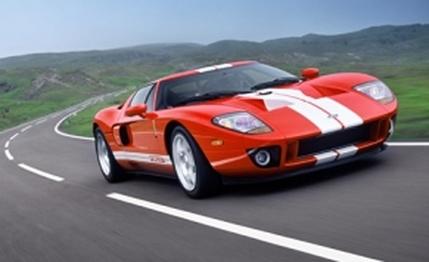
 First Drive Review
First Drive Review
Power? Check. Face distortion spoken here. The engineers say 60 mph in less than four seconds. We believe them.
Agility? If Marshall Faulk had moves like this, the NFL would have to put him in leg irons.
Grip? Oh, yeah. Hangs on like a bat in a wind tunnel. Ford expects adhesion north of 1.00 g. The only way it won't make that is if someone butters the skidpad.
Brakes? Raceworthy. The kind of potent, fade-free resource that's as essential to high-speed back-road entertainment as big horsepower. More essential, in fact.
All the foregoing applies to the 2005 GT, Ford's revivalist supercar that conjures up memories of the company's GT40 glory years at Le Mans in 1966, '67, '68, and '69.
Regular readers will recall two previous reports on this project: our February 2002 cover story, "Return of the Ferrari Slayer," and an update in July '03. In its debut at the 2002 Detroit show, the GT was just another dream car, production feasible but unlikely. What could it do for Ford's bleeding bottom line? Who could make a business case for it? Chairman Bill Ford himself posed that last question, and it was anything but rhetorical-more like an imperial mandate. Make a business case, do it in 30 days, and make sure the bottom line is black. We want to build this thing.
A hands-on session with a development mule earlier this year made it clear the GT would be more than show biz. The trestlesque aluminum tube chassis and coil-over control-arm suspension were essentially ready. What that prototype lacked was the real-deal production engine-the mule used a 390-hp, 4.6-liter supercharged V-8 from the SVT Mustang Cobra-plus the aero work needed for high-speed stability and the interior refinements to help the car measure up to its fancy price.
How fancy will that price be? Those in the GT program will only say "between $100,000 and $150,000." That's a big between. Our bet: When the GT goes on sale next spring, there won't be much air between the base price and that 150-grand ceiling.
Let's talk aero. The body development team began its work by putting a 1968 GT40 in a California rolling-road wind tunnel borrowed from race-car builder Swift Engineering of San Clemente. The results, per performance development supervisor Kent Harrison, were sobering. In addition to an indifferent coefficient of drag-about 0.43-front-end lift at high speeds was in the aircraft realm: The car wanted to fly.
"The tunnel data gave me new respect for Gurney and Foyt and all those guys going flat-out on the Mulsanne straight," he said. "Wow."
With no constraints, Harrison's job would have been simple: reduce Cd, reduce drag, and reduce lift. But of course there were constraints. For one, the team was stuck with the basic shape. For another, the GT is a bigger car than its ancestor-6.9 inches wider, 3.8 inches taller, and 18.3 inches longer.
Aero is a subtle business, and in fact the fine-tuning of the GT's aluminum skin is still in progress. Harrison was not prepared to give us a final Cd number, although he acknowledged the goal was "less than 0.39." However, the project had advanced to the point of acceptability at the time of this writing, thanks to a variety of adjustments to the GT concept's body shell. Included were a modest chin spoiler, rocker-panel extensions, a small ducktail curling up at the stern, wheel-well sculpting, and a system of rear diffusers channeling air from beneath the car's flat underbody. The team also routed warm air from the front-mounted radiators (for the engine and intercooler) past the side mirrors, rather than over the windshield, since the intake for the air conditioning resides below the windshield base.
Harrison says the shape's high-speed traits have gone from treacherous lift to modest downforce. We never saw speeds above 120 mph-team members talk about top speeds "in excess of 190 mph"-so we'll take Harrison's word for it until we can get a GT and do our own testing. We can say the door seals of these preproduction GTs allowed too much wind noise. But the body guys expect to improve this on the production car.